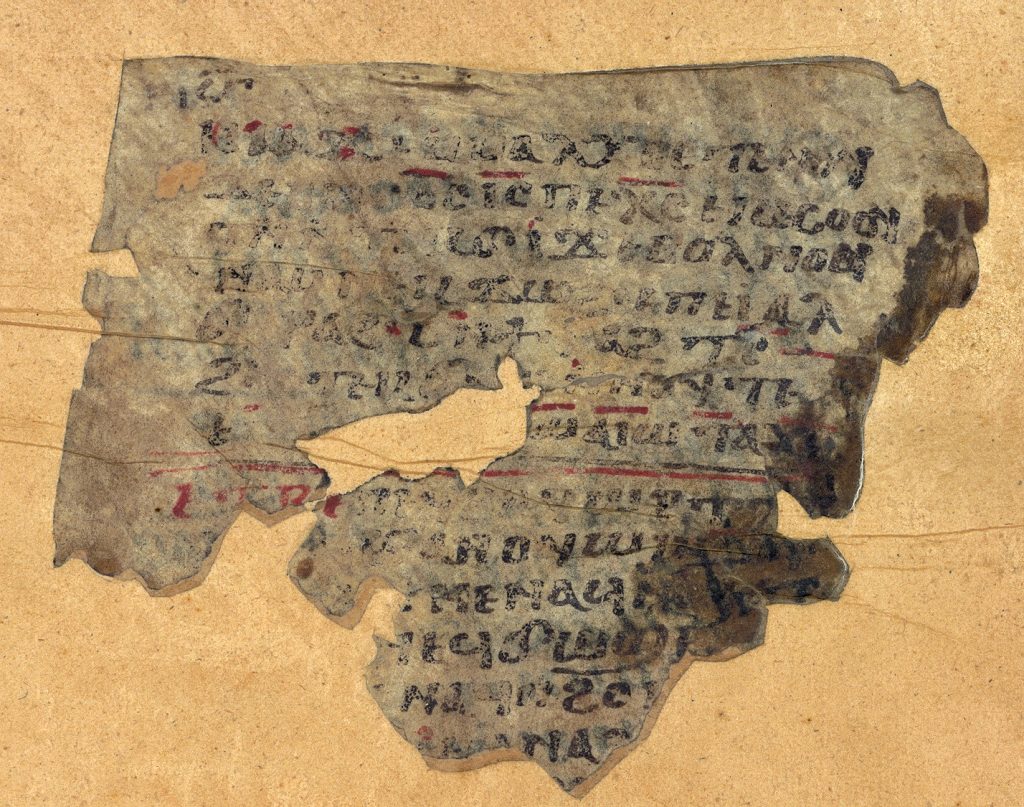In this series of blog posts, we will look at a parchment sheet kept at the Bibliothèque Nationale de France (BnF), BnF Copte 129 (20) fol. 178. On April 3rd, 1894, a modern codex was bound in France, comprising various miscellaneous, but mainly liturgical and biblical, texts. The Coptologist Émile Amélineau had acquired the manuscripts and catalogued them for the BnF a few years earlier. In the modern codex, the preceding and the following sheets are written in a different hand, and no other sheets in the codex resemble this one. Because its recto is numbered as page 22 and its verso as 23, we can assume that it originally formed part of a codex of at least 23 pages. The present location of the rest of the codex is unknown.

BnF Copte 129.20 fol. 178 (135), recto. Image by courtesy of the Bibliothèque nationale de France, Département des Manuscrits
The parchment sheet is fragmentary, and its bottom is missing. According to the BnF website, the manuscript comes from the White Monastery in Upper Egypt, but it was likely copied by scribes in the scriptorium of Touton in the Faiyum, due to some typical features of manuscripts from this site, such as the writing of dots instead of supralinear strokes. Parts of the text, such as the beginning of the prescriptions, are highlighted in red. It is written in non-standard Sahidic and, although it was associated with a monastery, the text is clearly ‘magical’; for instance, it contains phrases such as ‘yea yea, quickly!’, often found at the end of magical texts to urge supernatural beings to act faster. Based on the hand, it can be dated to between the 10th and 11th centuries CE. Most remarkably, it has the so-called flat μ (the horizontal stroke of the letter is in line with the imaginary writing line), which began to appear in the 10th century.
The manuscript contains three healing prescriptions, separated by dividing lines. The first one (A) is a prescription for a fumigation for a woman to give birth quickly, followed by a prayer to be used during the procedure. The entire prescription is preserved, but only a part of a prayer that accompanied it. The second one is the end of a prayer for treating deafness (B). We can assume that the bottom of the first page (that is, page 22 of the original codex) contained the rest of the prayer for the woman giving birth and also the ritual instructions that accompanied the prayer for deafness, as well as its beginning. The third text (C) is a prescription for an unclear issue; not even the famous Walter E. Crum, the editor of the Coptic dictionary, was able to decipher it (see CD 738a). We can assume that a prayer followed it. Perhaps this structure – a prescription followed by a prayer – was repeated throughout the entire codex. Finding other pages from this codex would be invaluable for the understanding of healing practices used in monasteries in this period in Egypt.

BnF Copte 129 (20) fol. 178, (134), verso. Image by courtesy of the Bibliothèque nationale de France, Département des Manuscrits
Here is the translation of pages 22 and 23:
(A) A woman suffering in labour: Fumigate her, she will give birth quickly. Say this prayer over a cup of wine, have her drink from it. She will give birth.
“In the name of [Jesus (?)]. A bunch of grapes, that he pressed upon the [holy] tree of the cross, help your servant (f. sg.), daughter of (?) … !”
Here, the fragment breaks off. On the verso (page 23), we read the end of a different prayer:
(B) […] the ear of Malchus. But now, Lord Jesus Christ, stretch out your right hand and touch this deaf, … I trust (?) in your power (?), O living God! Yea, yea, quickly!
Below this fragmentary prayer, a new prescription continues, before the manuscript breaks off again.
(C) Against his (?)… when he eats… for him (?)… and pour into/mix (?)… for him (?)…
In the next posts, we will take a closer look at the contents of the manuscript, in particular the ritual practice, and we will also discuss the mythological motives appearing in the prayers.
Note: Thanks to Tonio Sebastian Richter for helping me identify the origins of the manuscript and to Ágnes Mihálykó for telling me about the manuscript.
Bibliography
Crum, Walter E. A Coptic Dictionary. Oxford: Oxford University Press, 1939.
Mihálykó, Ágnes T., The Christian Liturgical Papyri: An Introduction. Tübingen: Mohr Siebeck, 2019.
Nakano, Chièmi. “Indices d’une chronologie relative des manuscrits coptes copiés à Toutôn (Fayum).” Journal of Coptic Studies 8 (2006): 147–159.
Preininger, Markéta. “BnF Copte 129 (20) fol. 178: Three Healing Prescriptions,” Archiv für Papyrusforschung und verwandte Gebiete 68/2 (2022): 344–357.
